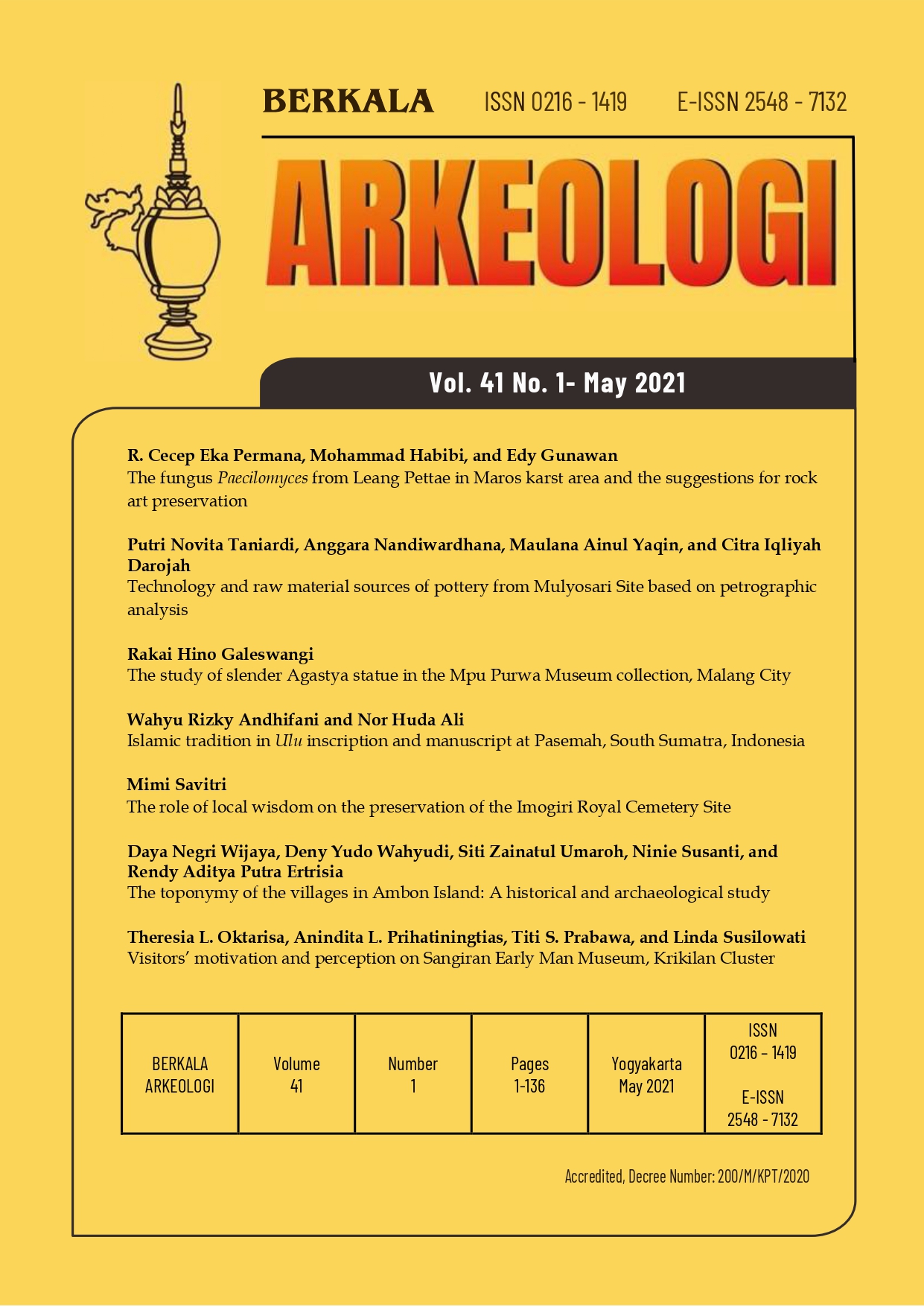The role of local wisdom on the preservation of the Imogiri Royal Cemetery Site Peran kearifan lokal terhadap upaya pelestarian Situs Makam Imogiri
Main Article Content
Abstract
The Imogiri Royal Cemetery Site has provided benefits to the surrounding community, especially abdi dalem as the caretakers of the site for a long time. The local community has created local wisdom in order to survive and continue to enjoy the benefits provided by the site. The question arises are: What is the benefit of the Imogiri Royal Cemetery Site for the surrounding community especially abdi dalem? What kind of local wisdom is created by the abdi dalem at the Imogiri Royal Cemetery Site? What is the role of local wisdom in the preservation of the Imogiri Royal Cemetery Site? This research was conducted to examine the role of local wisdom to preserve the Imogiri Royal Cemetery Site. The data collected using in depth-structure interviews. The analysis was carried out using an interpretive method with hermeneutic model of cultural interpretation. This research generates knowledge that local wisdom has contributed to the preservation of the Imogiri Cemetery Site. This is important to maintain the sustainability of the site's benefits and to improve people’s welfare.
Article Details

This work is licensed under a Creative Commons Attribution-NonCommercial-ShareAlike 4.0 International License.
References
Adiansyah, R. (2017). Persimpangan antara agama dan budaya (proses akulturasi Islam dengan slametan dalam budaya Jawa). Jurnal Intelektualita: Keislaman, Sosial dan Sains, 6(2), 295–310. https://doi.org/10.19109/intelektualita.v6i2.1612
Ahimsa-Putra, H. S. (2019). Bahasa, sastra, dan kearifan lokal di Indonesia. Mabasan, 3(1), 30–57. https://doi.org/10.26499/mab.v3i1.115
Amir, S., Osman, M. M., Bachok, S., & Ibrahim, M. (2015). Sustaining local community economy through tourism: Melaka UNESCO World Heritage City. Procedia Environmental Sciences, 28, 443–452. https://doi.org/10.1016/j.proenv.2015.07.054
Anonim. (n.d.). Babad Momana. Koleksi Badan Penerbit Soemodidjojo Mahadewa.
Aplin, G. (2002). Heritage: identification, conservation, and management. Oxford University Press.
Ashmore, W., & Knapp, A. B. (Ed.). (1999). Archaeologies of landscape: contemporary perspective. Blackwell.
Astuti, W. (2006). Studi teknis kompleks makam Imogiri tahap I. Balai Pelestarian Cagar Budaya D.I. Yogyakarta.
Aznar, M., & Hoefnagels, H. (2019). Empowering small rural communities through heritage tourism. In Delivering Tourism Intelligence (hal. 49–60). Emerald Publishing Ltd. https://doi.org/10.1108/S2042-144320190000011005
Bernbaum, E. (2006). Sacred mountains: themes and teachings. Mountain Research and Development, 26(4), 304–309. https://doi.org/10.1659/0276-4741(2006)26[304:smtat]2.0.co;2
Bonotan, G., & Lee, E. (Ed.). (2010). Perspectives on heritage tourism. SEAMEO-SPAFA.
BPS Kabupaten Bantul. (2019). Kecamatan Imogiri dalam angka 2019. BPS Kabupaten Bantul.
Campelo, A., Reynolds, L., Lindgreen, A., & Beverland, M. (2018). Cultural heritage (A. Campelo, L. Reynolds, A. Lindgreen, & M. Beverland (Ed.)). Routledge. https://doi.org/10.4324/9781315107264
Cotter, M., Boyd, B., & Gardiner, J. (2001). Understanding communities: valuing place, an introduction. In M. Cotter, B. Boyd, & J. Gardiner (Ed.), Heritage Landscape: Understanding Place and Communities (hal. 335–336). Southern Cross University Press.
Denzin, N. K., & Lincolin, Y. S. (2007). Handbook of qualitative research. Pustaka Pelajar.
Diaz-Andreu, M., Lucy, S., Babic, S., & Edwards, D. N. (2005). The archaeology of identity: approaches to gender, age, status, ethnicity and religion. Routledge.
Endraswara, S. (2012). Metodologi penelitian kebudayaan. Gadjah Mada University Press.
Fraser-Lu, S. (1986). Indonesian batik processes, patterns and places. Oxford University Press.
Graaf, D. H. J. de. (1986). Puncak kekuasaan mataram. Pustaka Grafiti Pers.
Heins, M. (2004). Karaton Surakarta. Yayasan Pawiyatan Kabudayan Karaton Surakarta.
Herusatoto, B. (2008). Simbolisme Jawa. Ombak.
Izdiha, A. (2019). Wedang uwuh, daya pikat cita rasa lokal. Mayangkara, 8, 60–61.
Kealiikanakaoleohaililani, K., Kurashima, N., Francisco, K., Giardina, C., Louis, R., McMillen, H., Asing, C., Asing, K., Block, T., Browning, M., Camara, K., Camara, L., Dudley, M., Frazier, M., Gomes, N., Gordon, A., Gordon, M., Heu, L., Irvine, A., … Yogi, D. (2018). Ritual + sustainability science? a portal into the science of aloha. Sustainability, 10(10), 3478. https://doi.org/10.3390/su10103478
Lota, H. (1993). Album pasareyan raja-raja Mataram.
Mangunwijaya, Y. B. (2013). Wastu Citra. PT Gramedia Pustaka Utama.
Njatrijani, R. (2018). Kearifan lokal dalam perspektif budaya kota Semarang. Gema Keadilan, 5(1), 16–31.
Prajnawrdhi, T. A., Karuppannan, S., & Sivam, A. (2015). Preserving cultural heritage of Denpasar: local community perspectives. Procedia Environmental Sciences, 28, 557–566. https://doi.org/10.1016/j.proenv.2015.07.066
Prawirawinarsa, R., & Djajengpranata, R. (1921). Babad Alit. Volkslectuur.
Rani, F. P., Kusuma, H. E., & Ardhyanto, A. (2018). Pariwisata pusaka: destinasi dan motivasi wisata di pusaka saujana Imogiri Yogyakarta. Jurnal Planologi, 15(2), 149–163. https://doi.org/10.30659/jpsa.v15i2.3524
Ridwan, N. A. (2007). Landasan keilmuan kearifan lokal. Ibda`, 5(1), 27–38.
Sarwono. (2016). Mapping and protecting the intellectual property right in the field of the traditional batik design of tirtomoyo as the cultural heritage and its development based on the local genius in the creative industrial era. Yustisia Jurnal Hukum, 5(3), 622–642. https://doi.org/10.20961/yustisia.v96i0.5020
Savitri, M. (2015). Peran magis-religius Bengawan Solo dalam pendirian kota Surakarta abad ke-18. Kalpataru, 24(1), 37–46. https://doi.org/10.24832/kpt.v24i1.59
Savitri, M. (2016). Landscape transformation: from Sala village to the capital of Mataram kingdom. Spafa Conference.
Sedyawati, E. (2010). Budaya Indonesia: kajian arkeologi, seni, dan sejarah. Rajawali Press.
Smith, L. (2006). Uses of heritage. Routledge. https://doi.org/10.4324/9780203602263
Spradley, J. P. (1979). The ethnographic interview. Waveland Press.
Stephens, J., & Tiwari, R. (2015). Symbolic estates: community identity and empowerment through heritage. International Journal of Heritage Studies, 21(1), 99–114. https://doi.org/10.1080/13527258.2014.914964
Sudrajat, S. W. (2016). Pemahaman tentang menejemen bencana alam siswa sekolah menengah pertama. Jipsindo, 3(2), 168–189. https://doi.org/10.21831/jipsindo.v3i2.11697
Sumartono, D. A. (2019). Catatan silam pajimatan Imogiri. Mayangkara, 8, 22–25.
Sutjipto, F. A. (1977). Unsur sejarah dalam sastra sejarah. Buletin Fakultas Sastra dan Kebudayaan, 5, 111–120.
Suwarjo. (2019). Community based tourism dalam pengelolaan desa wisata Giriloyo, Wukirsari, Imogiri, Bantul. Populika, 7(1), 66–80. https://doi.org/10.37631/populika.v7i1.28
Tanudirjo, D. A. (2003). Warisan budaya untuk semua: arah kebijakan pengelolaan warisan budaya Indonesia di masa mendatang. Makalah disampaikan pada Kongres Kebudayaan V, Bukittinggi, 19–23.
Tuan, Y.-F. (1977). Space and place, the perspective of experience. Edward Arnold.
Utama, B. (2013). Bertani dengan arif: pertanian organik sebagai alternatif mewujudkan kedaulatan pangan. In E. J. M. Prioharyono (Ed.), Kearifan Lokal & Lingkungan (hal. 61–78). Pusat Penelitian dan Pengembangan Kebudayaan, Kementerian Pendidikan dan Kebudayaan.
Wedhawati. (1980). Babad Nitik sarta Cabolek Kanjeng Sinuwun Sultan Agung ing Mataram. Balai Bahasa.

